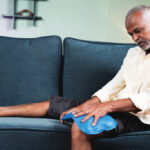
PARIS, FRANCE—In the first phase 3 results on sarilumab—the first fully human monoclonal antibody directed to the interleukin (IL)-6 receptor—patients taking the drug and methotrexate performed significantly better than methotrexate alone in a variety of areas, researchers said at the Annual European Congress of Rheumatology (EULAR 2014) in June.
The results, the first in a slate of ongoing phase 3 trials on sarilumab, were part of a series of findings unveiled in a session on non-tumor necrosis factor (TNF) biologics.
Mark Genovese, MD, professor of immunology and rheumatology at Stanford University, Palo Alto, Calif., presented the findings. The trial was sponsored by Sanofi and Regeneron Pharmaceuticals Inc.

The 52-week international trial, called SARIL-RA-MOBILITY, enrolled 1,197 patients with moderate-to-severe rheumatoid arthritis (RA) who had not responded adequately to methotrexate. They were randomized to receive, every other week, 150 mg of sarilumab plus methotrexate, 200 mg of sarilumab plus methotrexate, or a placebo and methotrexate.
“[With] both doses of sarilumab, with methotrexate as a background agent, we’re able to show clinically relevant improvements, as well as statistically significant outcomes,” Dr. Genovese said.
At 24 weeks, 58% of the 150 mg group had achieved ACR20 (a 20% improvement over baseline), as had 66% of the 200 mg group and 33% in the placebo group. At 16 weeks, the two treatment groups experienced more improvement over patients in the placebo group on the Health Assessment Questionnaire Disability Index, a measurement of physical function. And at 52 weeks, there was greater inhibition of structural progression in the sarilumab groups, compared with placebo. These were all statistically significant results.
There were more treatment-emergent adverse events in the sarilumab groups—321 in the 150 mg group, 331 in the 200 mg group and 263 in the placebo group. Fifty-nine patients discontinued treatment because of adverse events in the 200 mg group, and 54 did so in the 150 mg group, compared with 20 in the placebo group.
Abatacept & Drug-Free Withdrawal
Another study found that for patients with highly active early RA and a poor prognosis, abatacept and methotrexate led to significantly higher rates of remission over just methotrexate at 12 months. And a small—but significantly higher—number of patients treated with abatacept plus methotrexate stayed in drug-free remission compared to those who’d only been on methotrexate, said Paul Emery, MD, professor of rheumatology at the University of Leeds, West Yorkshire, England.

In the AVERT study, a total of 351 anti-CCP-2-positive, methotrexate-naive patients were randomized to 125 mg of abatacept plus methotrexate, abatacept alone or methotrexate alone. At 12 months, 60.9%, 42.5% and 45.2% had achieved DAS28 scores of less than 2.6 in the abatacept plus methotrexate, abatacept alone and methotrexate alone groups, respectively. The safety and efficacy of abatacept in these patients have been previously published.1
Treatment was withdrawn after 12 months, and most patients discontinued because of an increase in disease activity. But those in the abatacept-plus-methotrexate groups were more than twice as likely as the methotrexate-alone group to have DAS28 scores of less than 2.6 at both months 12 and 18, researchers found.
A review of MRI scans found bigger improvements in synovitis, osteitis and erosion scores in the abatacept-plus-methotrexate group than methotrexate alone, said Charles Peterfy, MD, PhD, an imaging specialist with Florida-based Spire Sciences.
“AVERT is the first study to show sustained remission following the withdrawal of all RA therapy,” Dr. Emery said. “And it’s clear that those patients with a shorter duration and lower baseline disease activity and longer DAS remission—which is essentially a very early patient—were the ones more likely to sustain drug-free remission.”
Safety & Efficacy of Itolizumab
Researchers from India presented phase 2 data on the safety and efficacy of itolizumab, a first-in-class anti-CD6 antibody.
Seventy patients with active RA and inadequate response to methotrexate were randomized to receive one of three doses of itolizumab (0.2, 0.4 or 0.8 mg/kg) plus methotrexate or methotrexate alone. They were given 12 weeks of the treatment, followed by 12 weeks of methotrexate alone.

Itolizumab patients had higher ACR20 response rates at Week 12 than those in the methotrexate group, and this difference in response was sustained at Week 24.
For every 100 infusions, there were 3.57 acute infusion reactions, with fever and cough the most common adverse events.
“These results provide strong preliminary evidence for the safety and efficacy of itolizumab in combination with methotrexate,” said Arvind Chopra, MD, of the Center for Rheumatic Diseases in Pune, India.
Infections from Rituximab
In another study, researchers examined whether taking rituximab, an anti-CD20 monoclonal antibody, increased the risk of serious infections in clinical practice.
Investigators used the British Society for Rheumatology Biologics Register, an ongoing national prospective register of RA patients started on a biologic therapy, said Lucia Silva, MD, clinical research fellow at the University of Manchester, United Kingdom.

They looked at patients who’d failed an anti-TNF and were then switched either to another anti-TNF or rituximab from 2001–2012. Patients were followed by physician visits and questionnaires.
Serious infections were those requiring intravenous antibiotics, hospitalization or both, and infections causing death.
Researchers found no difference in the risk of the infections. In the first year of follow-up after treatment was switched, 158 of 3,237 anti-TNF patients had at least one serious infection. And 47 of the 1,018 rituximab-treated patients had at least one.
Thomas R. Collins is a freelance medical writer based in Florida.


